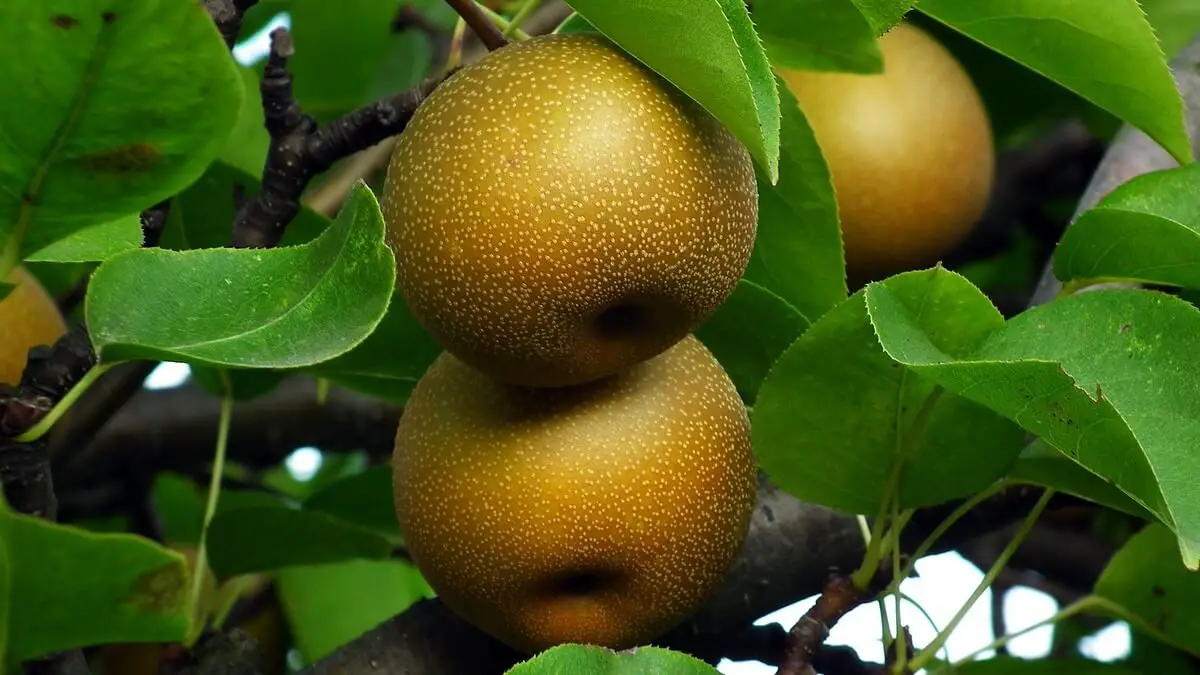How to Grow an Asian Pear Tree
The Asian pear tree (pyrus pyrifolia) belongs to the Rosaceae family. Other popular members of this family include peach, nectarine, and apple trees. It is indigenous to the East Asian region. The edible fruit of this tree has many names including Chinese pear, Asian pear, Japanese pear, zodiac pear, apple pear, and sand pear.
This article focuses on the Asian pear tree (pyrus pyrifolia), its characteristics, propagation, caring, and uses.
Typically, the cultivars of these trees grow across east Asian regions and also in New Zealand, Australia & the USA.
In east Asia, you can find these trees commonly in gardens, inhabitant lands, rural areas, and even roadsides in some places. The flowers of these trees are a traditional symbol of spring in some of these regions.
Larger in size, the fruits have a sweet fragrance. You can simply wrap them and store them safely in a cool place. They can last for a few weeks.
Unlike European varieties, the fruits of these trees have high water content and have a grainy crispy texture like an apple. So, these fruits are not suitable for making jams or baking in pies.
Instead, you can consume them raw as snacks or slice them to add in salads and other green dishes. These fruits are rich in fibers, Vitamins K, and C.
Table of Contents
History
In the eastern Asian region, these trees have been in cultivation for more than 3,000 years. Indigenous to western Chinese lands, these trees have neutralized in Japan, Korea, and other nearby lands with time.
In 1820, William Prince, a horticulturist imported these plants to grow them in Flushing (New York).
Later, during the times of the Gold Rush, early Chinese miners planted them in California. After that, the Japanese immigrants planted various cultivars in the early 1890s.
To this day, China, Japan, and Korea take lead in exporting these fruits all over the world. In the United States, you can find these plants commonly growing in California, Washington, and Oregon regions.
Characteristics of Asian Pear Tree

After propagation, the Asian pear tree (Pyrus Pyrifolia) takes 3 – 5 years for producing fruits. During spring, these trees bloom fragrant white flowers. After that, they produce fruits in 4 – 7 months. The time period depends on the cultivar type and growing conditions.
Normally, these trees require 300- 500 hours of chillness (less than 45°F) in winter to set fruit. Even the warmer zones (USDA 8 or 9) can meet these requirements in winters.
Upon ripening, European varieties turn mushy and soft. But Asian varieties do not do so. Like apples, each fruit has five seeds inside.
The Asian varieties are known for their juicy and crispy texture. They mostly have a round shape with yellowish-green skin. However, the color, size, and shape vary depending on the cultivar type.
Botanically, Asian pears are true pears. Interestingly, the fruits of some cultivars look and taste like apples. But they are true varieties and not hybrids.
Pollination
Some cultivars like 20th Century, Tennosui, and Shinseiki are self-pollinating. However, most other varieties are cross-pollinating. It is advisable to interplant multiple varieties that bloom at the same periods for cross-pollination. This increases the yield.
The Asian pear varieties can also cross-pollinate with European pear varieties. For Instance, you can plant P. pyrifolia in combination with a European variety. This attracts honeybees to flock on both trees.
Propagation of Asian Pear Tree
Asian pear tree (Pyrus Pyrifolia) varieties prefer to grow in sunny locations. So, if you live in USDA zones 5-7, select a space that receives at least 8 hours of full sun. If you happen to live in USDA Zones 8-9, select a space that gets some afternoon shades. This helps to neutralize the heat.
Make sure the site has moderately loose soil with a Ph value between 6-7. Amend the soil with organic matter prior to planting.

Photo by Calyponte (CC BY-SA 4.0)
There are various methods to propagate these trees. The commonly used method is Grafting. But the success ratio of this method depends on experience and skills. You can also try micropropagation methods through tissue cultures.
The cutting propagation method has a success ratio anywhere between 30-90 percent. However, it needs a lot of serious attention including professional greenhouse setups. So, most gardeners avoid this method.
We have elaborated the seed propagation method and seedlings propagation method below.
Mostly, these trees grow in excess of 12 m (40 feet) in height. Makes sure to distance these plants at least 20 – 25 feet apart. Even the dwarf varieties require about 12 -15 feet safe distance between them.
From Seeds
This method requires Stratification of the Seeds and long germination periods. However, there is no guarantee that the new tree will be the exact replica of the parent tree.
1.) Collect the seeds from fruits in February. You can also purchase them online or offline in nurseries.
2.) Soak them overnight in a water-filled bowl. The next morning, dispose of the floating seeds. Collect the sunken seeds and soak them again in a bleach mixture (10 parts water and one part of powder bleach) for about 10 minutes. Then, rinse them thoroughly.
3.) Fill a resealable plastic bag with damped peat moss. Push the seeds 2-3 inches deep into the peat moss.
4.) Place the bag in your refrigerator’s crisper drawer for 2 -3 months. Maintain the peat moss dampness by spraying water as needed.
5.) You can remove the bag when the outdoor temperature is consistently above 40 ° F (4 ° C). Remove the seeds from the peat moss. Soak them in a warm water bowl for two days. Dispose of the floating seeds. Collect the sunken seeds separately.
6.) Sow the seeds 1/2-inch-deep in a pot filled with potting soil. Water twice or thrice a month to maintain dampness. When you see at least 2 sets of true leaves, your plant is ready for transplantation. Transplant it in May or June. This gives time to roots for establishing themselves before winter.
7.) Dig a hole that is wider than the root spread and at least 3 inches deep. Place the seedling inside the hole and tighten it with mud.
Water regularly and maintain the soil moisture. You can also tie a stack to the seedling for encouraging upright growth.
From Seedlings
This is one of the easiest methods to propagate an Asian pear tree (Pyrus Pyrifolia). You can purchase seedlings online from Amazon or any garden center. We recommend you purchase at least two varieties that bloom at the same time to facilitate cross-pollination. Multiple varieties promote cross-pollination further. Start the process in the spring or early fall.
1.) Dig a hole as deep as and twice as wide as the root ball.
2.) Insert the root ball holding the plant in an upright position. Make sure the tree crown is at the same level as the soil surface.
3.) Tighten the seedling with two parts of soil and one part of manure.
4.) Water thoroughly. Maintain the soil moist at least during the first few years of the sapling’s growth.
5.) You may stop watering throughout the freezing season. But, start watering as soon as the frost passes.
Alternatively, you can grow dwarf varieties in containers if you have space constraints. Container growing is well suited for small backyards or patios. Typically, this helps to move the plants indoors during the intense summer heat in warmer regions.
Caring of Asian Pear Tree
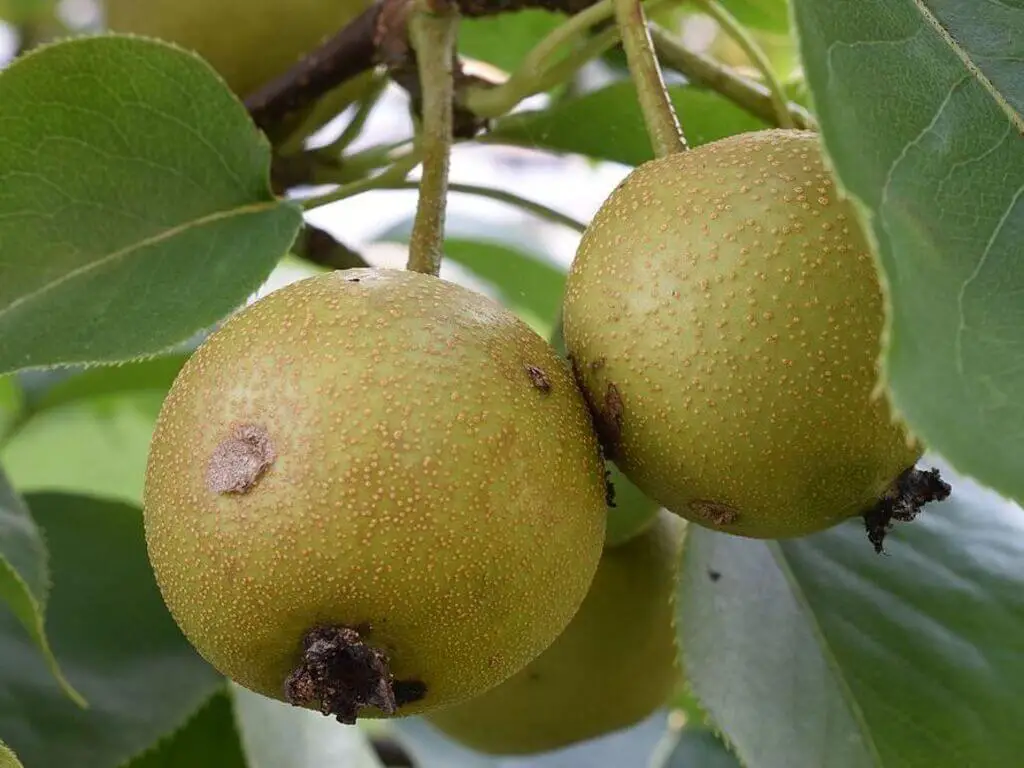
Photo by PumpkinSky (CC BY-SA 4.0)
1.) Mammals love to eat the soft bark of the young tree. So, Install a tree guard around the tree base. When the bark develops roughness, you can remove the guard.
2.) The roots of young trees may not be accustomed to pull enough water. So, just maintain the soil moisture by watering once or twice a week at least in the first year. Water in the early mornings aiming at the base of the tree. Avoid overwatering.
3.) Using a good quality weed remover, pull out the weeds regularly. Add mulch around the trees. This helps to suppress weeds growth and retain the soil moisture content. In warm areas, light-colored mulch keeps the roots cool!
4.) Amend the soil with fertilizer at least once a year during spring. You can use ammonium nitrate fertilizer. The quantity could be 0.057 kg (1/8 pound) multiplied by the tree’s age. If the foliage decolorizes, increase the quantity. If the tree grows beyond 0.30m (12 inches) in one season, decrease the quantity.
5.) As a general rule, the distance between the branches needs to be 12 inches. This encourages more yield across all branches. Start pruning in the spring. Using good quality garden shears, prune off the dead, entangled, or diseased branches and dead foliage. Remove the debris immediately. This improves the airflow around the trees.
6.) To enhance the fruit-bearing capabilities, maintain the tree’s height of about 5-6 inches by pruning. Also, it is easy to harvest the tree at this manageable height.
Pests and Diseases
Generally, the Asian pear tree (Pyrus Pyrifolia) is not bothered by pests and diseases. However, there are a few troubles to look out for.
Herbivores Animals
Some Herbivores animals do bother these trees. You can use animal repellants to keep them away. In fact, fencing is the best way to keep the animals out.
Insects
Codling Moth (Carpocapsa pomonella)
Typically, these insects lay small translucent eggs on the foliage. The Larvae usually have white bodies and blackheads. In most cases, the codling moths feed on fruits, making them inedible.
You can treat moths effectively with bacillus thuringiensis or horticultural oil.
Twospotted spider mites (Tetranychus urticae)
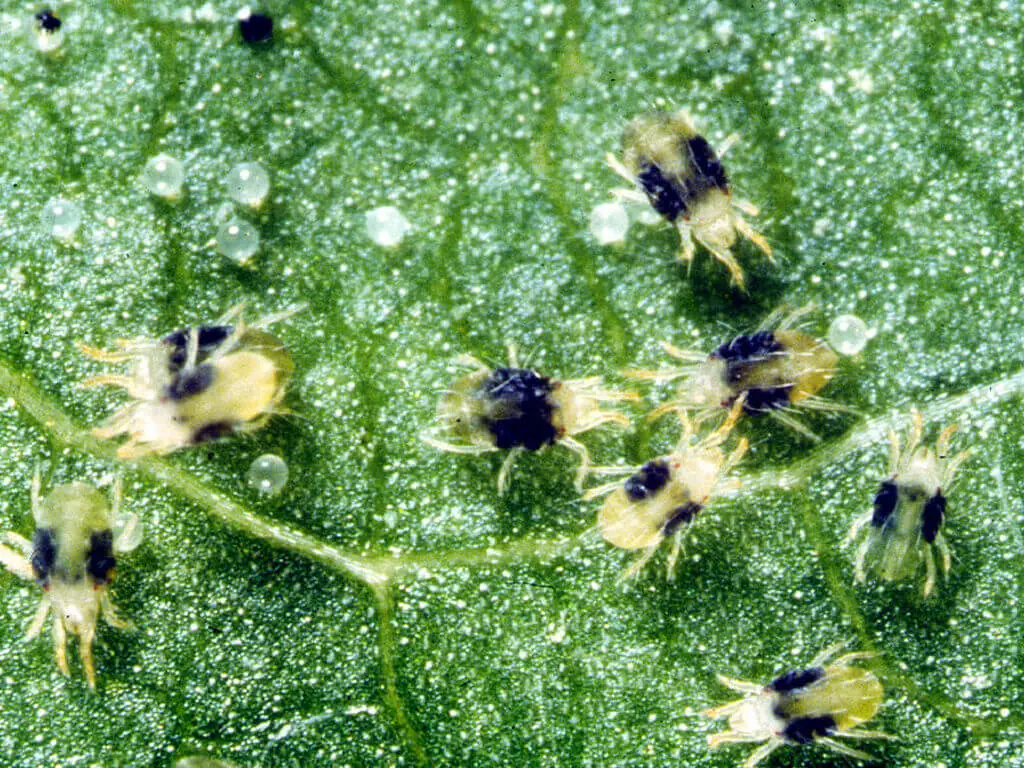
Usually, the two-spotted spider mite (Tetranychus urticae) appears in brownish-green color. They infest the foliage and suck the sap out. The affected leaves turn yellowish and completely dry out.
The infected plants produce undersized, poor quality fruits. If the infection is severe enough, the plants may shed leaves and die ultimately.
This insect usually infects water-stressed plants, mostly in hot summers. Just water your saplings well to prevent these mites. If the infection is severe, you can treat them with miticide sprays.
Diseases
Fire Blight
Except for ‘Shinko’, all Asian pear varieties are susceptible to Fire blight. it destroys the fruits and turns the foliage brown. As a result, the infected tree dies. However, the chance of recovery increases with early treatment.
In the initial stages of infection, the leaves start to shrivel. At that point, you can safely remove the infected portion and dispose of it. Sterilize the shears before using them again.
To prevent this disease, apply Liquid Copper Fungicide to the buds annually in the spring.
Harvesting
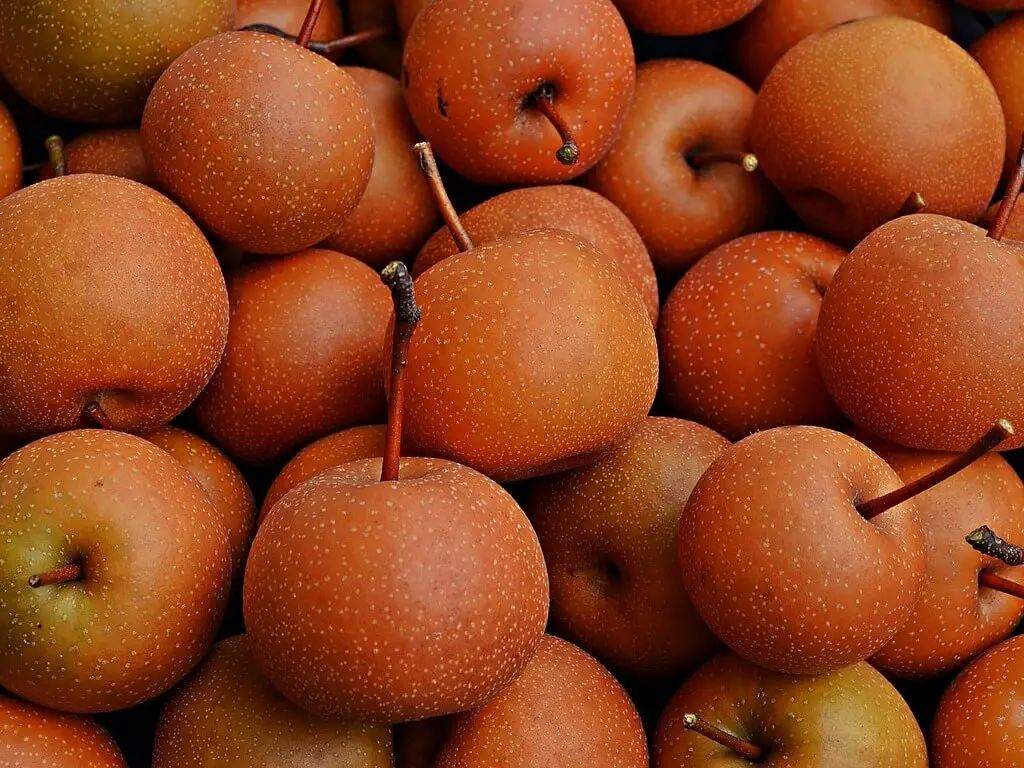
Generally, Asian pear trees (Pyrus Pyrifolia) bear fruit after three years. This time period may vary a bit depending on the cultivar type and the growing environment. Usually, the harvesting period is between mid-July and October depending on the variety.
Normally, the European pear varieties are plucked up before maturing and allowed to ripen in storage. On the other hand, the Asian pear varieties are left to ripen on trees.
By observing the color and size of the fruit, you can determine its ripening level. However, you may need the experience to improve this skill. In fact, tasting one of the fruits is the easiest method of identifying the ripening level of similar-looking fruits
Asian pears are susceptible to bruising. So, try to harvest them as early as possible from the trees.
Preservation
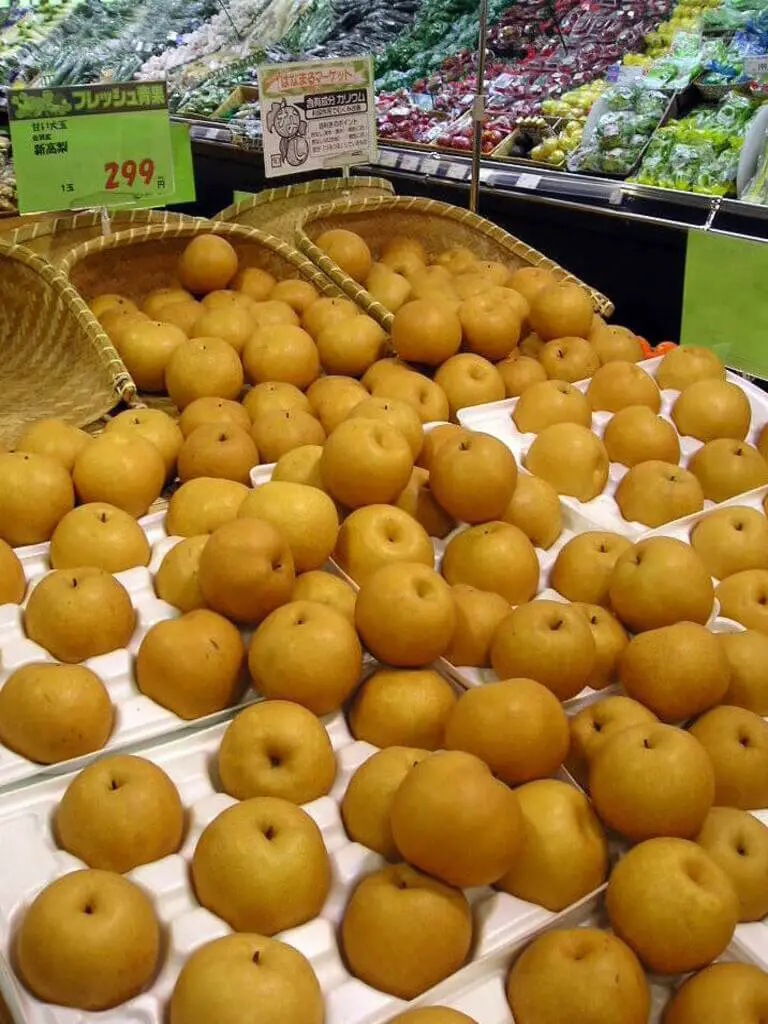
Photo by advencap (CC BY-SA 2.0)
Generally, you can store the Asian pears at room temperatures for about 7 -9 days. But refrigerating can extend their shelf life for about 3 months. Just pack them in common plastic or paper bags and store them in the chiller compartment of your refrigerators.
However, before consuming them raw, keep them at room temperatures until the chillness changes. In this way, you can enjoy the full tasty, crispy, and delicious flavor of these fruits.
Uses of Asian Pear Tree
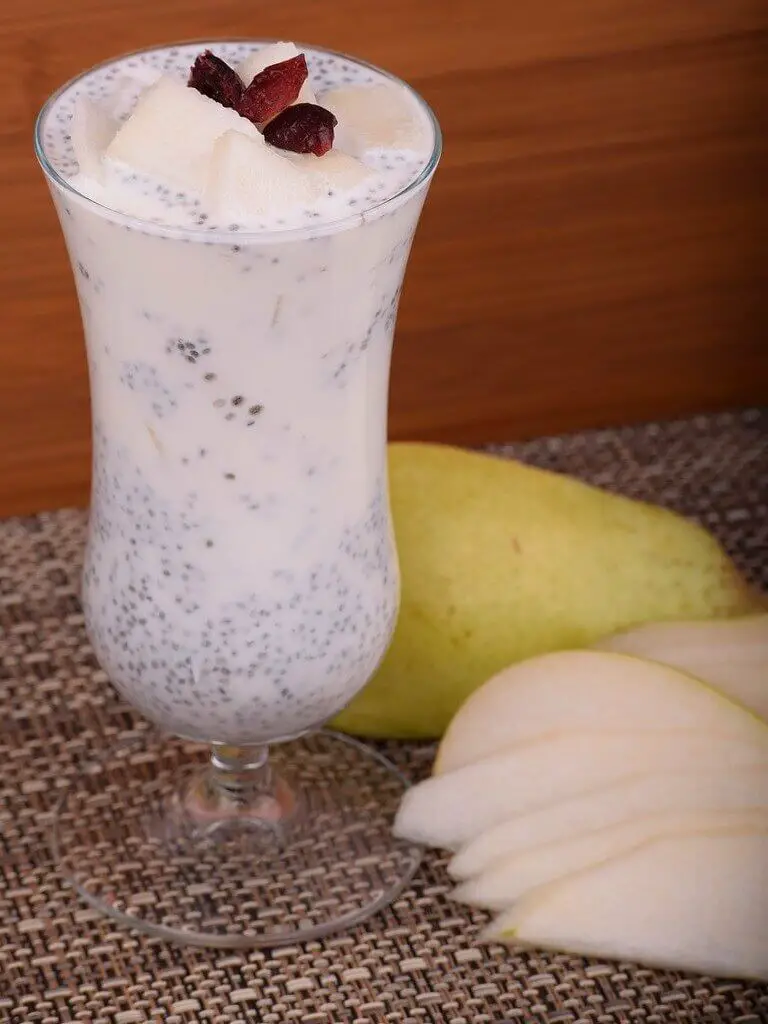
Salads
Slice the fruits and use them in leafy green salads with onions and cashews. You will love the sweet, crispy, and leafy combination.
Juices
Enjoy the deliciously nourishing juicy drink of pears every morning. Its vitamins and fibers provide you adequate energy to deal with the morning blues.
Sauces
These fruits serve as key ingredients in various sauce varieties. Among them, the apple-pear sauce is highly popular in the food industry. You can also prepare apple-pear sauce at home or purchase online.
Other recipes
There are hundreds of delicious pear recipes available! It needs a separate blog as a whole to explain each of them. You can find popular recipes in handy guides readily.
Similar Posts
How to Grow Swan River Daisy Plants
How to Grow Stock Flower Plants

